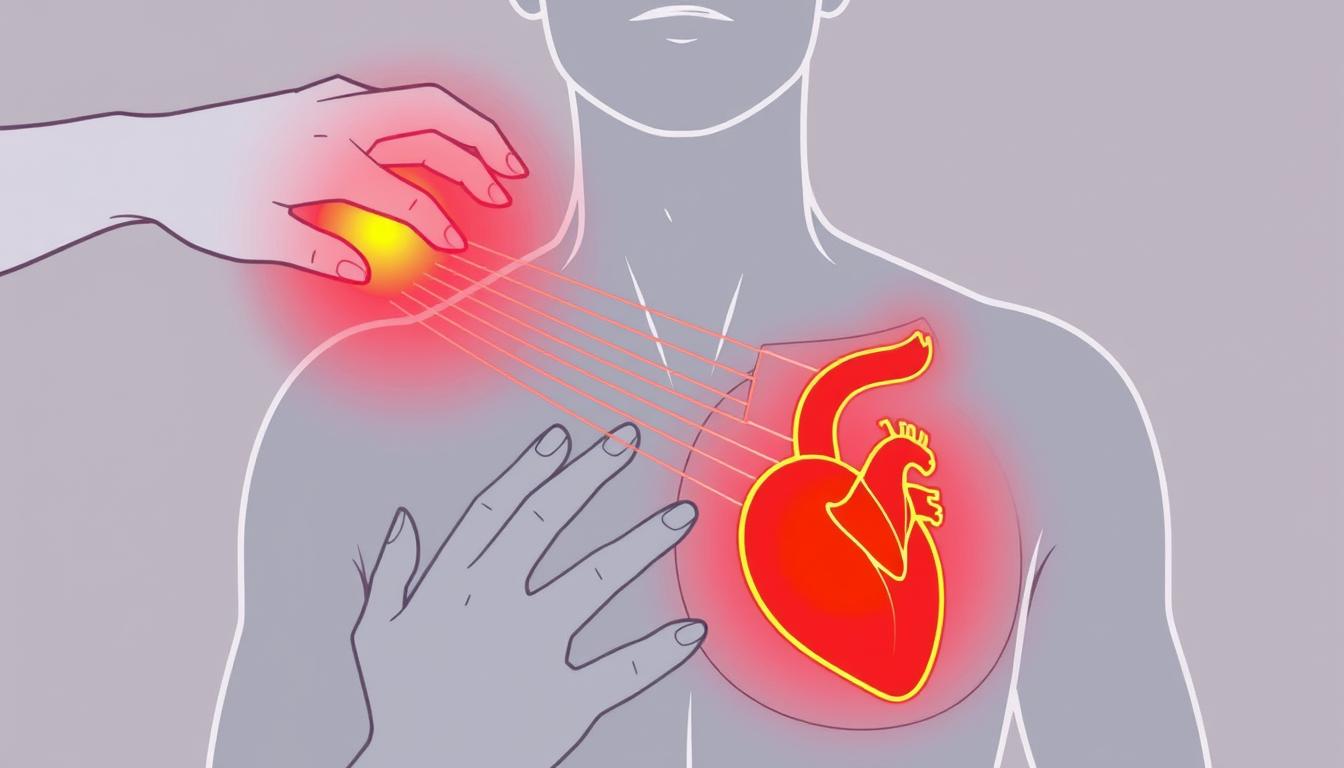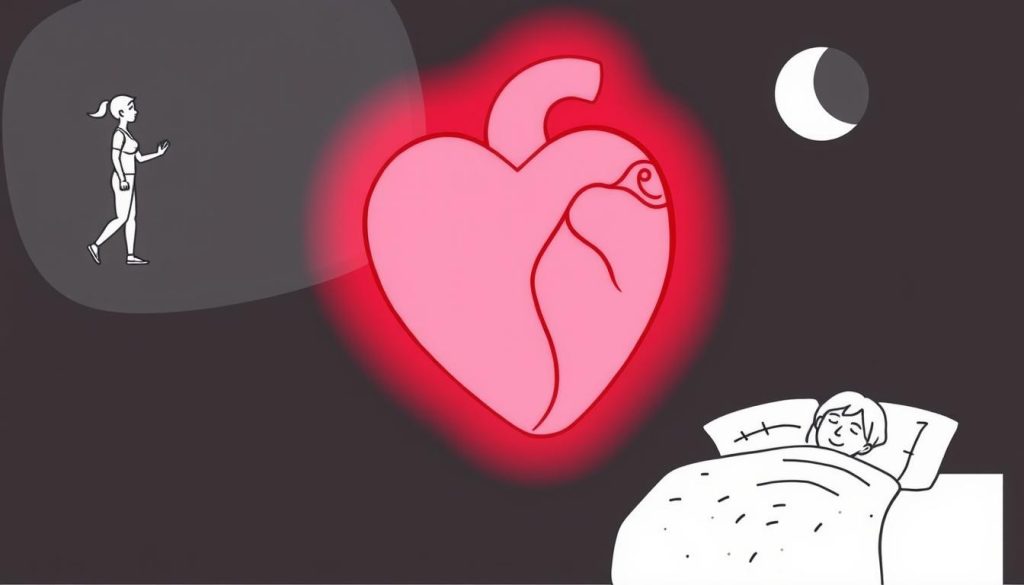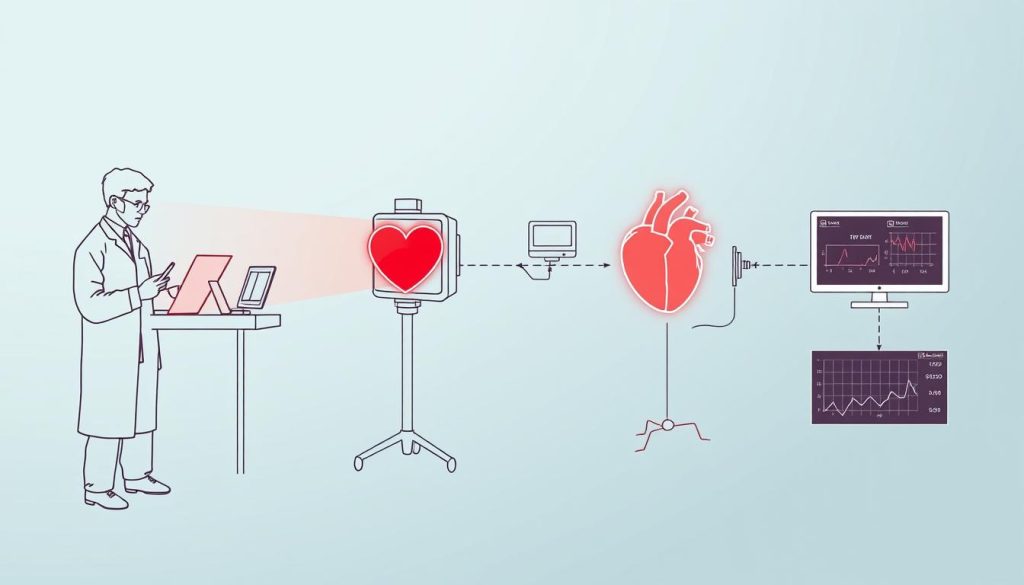Cardiovascular disease remains the leading cause of death globally, prompting many to seek complementary approaches to traditional care. Red light therapy—also known as photobiomodulation—has emerged as a promising non-invasive technique that may offer support for heart health. This article examines the scientific evidence behind red light therapy for heart conditions and explores how this technology might benefit your cardiovascular wellness routine.
What Is Red Light Therapy and How Does It Work?
Red light therapy uses specific wavelengths of red and near-infrared (NIR) light to penetrate skin and tissue, reaching cells and potentially stimulating beneficial biological effects. Unlike ultraviolet light, these wavelengths don’t damage skin cells but instead appear to enhance cellular function.
Red and near-infrared light can penetrate tissue at different depths, potentially reaching cardiovascular structures
The primary mechanism involves light absorption by mitochondria—the cellular powerhouses—particularly by an enzyme called cytochrome c oxidase. This interaction appears to increase adenosine triphosphate (ATP) production, the energy currency of cells, while also triggering beneficial signaling pathways that reduce inflammation and oxidative stress.
For heart tissue specifically, research suggests red light therapy may improve blood flow, reduce inflammation in cardiac tissue, and potentially support the heart’s ability to contract efficiently. These effects could be particularly valuable for individuals with cardiovascular concerns.
Scientific Evidence: Red Light Therapy for Heart Health
The scientific community has been investigating red light therapy’s effects on cardiovascular health with promising results. Here are some key findings from human clinical studies:
While many studies show promise, it’s important to note that research specifically on red light therapy for heart conditions in humans is still developing. Most compelling evidence comes from animal models, with human studies focusing primarily on related cardiovascular markers like blood pressure and inflammation.
Potential Cardiovascular Benefits of Red Light Therapy
Potential cardiovascular mechanisms of red light therapy for heart health
Based on current research, red light therapy may offer several potential benefits for cardiovascular health:
Improved Blood Flow
Red light therapy appears to stimulate the release of nitric oxide, a molecule that helps blood vessels dilate. This vasodilation can improve circulation and potentially lower blood pressure. According to a study published in the Journal of Biophotonics, red light therapy increased blood flow in the treated areas by promoting nitric oxide production.
Reduced Inflammation
Chronic inflammation is a key contributor to heart disease. Research suggests that red light therapy may help reduce inflammatory markers throughout the body, including those associated with cardiovascular disease. This anti-inflammatory effect could help protect blood vessels and heart tissue from damage.
Enhanced Mitochondrial Function
The heart is extremely energy-demanding and contains a high concentration of mitochondria. By stimulating ATP production in these cellular powerhouses, red light therapy may help improve cardiac energy metabolism. This is particularly relevant since mitochondrial dysfunction is linked to various heart conditions.
Potential Tissue Repair
Some studies suggest that red light therapy may help regenerate damaged heart tissue by activating stem cells. Research published in Lasers in Surgery and Medicine found that low-level laser therapy applied to bone marrow could mobilize stem cells to help repair heart damage following a heart attack.
Optimal Wavelengths for Cardiovascular Support
Not all red light is created equal when it comes to potential heart benefits. Research indicates that specific wavelengths appear most effective for cardiovascular applications:
Different wavelengths penetrate to varying depths, with longer wavelengths reaching deeper tissues
| Wavelength | Penetration Depth | Potential Cardiovascular Benefits |
| 630-633 nm (Red) | Superficial (2-3 mm) | Stimulates blood flow in superficial vessels, may help with skin-level circulation |
| 660 nm (Red) | Moderate (8-10 mm) | Enhances nitric oxide release, supports vascular function |
| 810 nm (NIR) | Deep (30-40 mm) | Reaches deeper tissues, may affect heart muscle directly |
| 830 nm (NIR) | Deep (30-50 mm) | Shown to reduce inflammation, support mitochondrial function |
| 850 nm (NIR) | Deep (30-50 mm) | May help with tissue repair and cellular energy production |
| 1064 nm (NIR) | Deepest (50-70 mm) | Potentially reaches heart tissue directly, supports deep tissue healing |
For cardiovascular applications, devices that offer both red (630-660 nm) and near-infrared wavelengths (810-1064 nm) may provide the most comprehensive benefits. The red wavelengths support superficial blood vessels and circulation, while the near-infrared wavelengths can penetrate deeper to potentially reach heart tissue.
High-quality devices like the Total Spectrum Elite incorporate seven clinically-validated wavelengths (630/633 nm, 660 nm, 808/810 nm, 830 nm, 850 nm, and 1064 nm), providing comprehensive coverage for potential cardiovascular support. You can compare leading panels side-by-side here to find the optimal wavelength combination for your needs.
Treatment Protocols for Heart Health
While research is still evolving on optimal protocols specifically for heart health, here are evidence-based guidelines for using red light therapy that may support cardiovascular wellness:
Proper positioning for red light therapy targeting the chest area
How often should I use red light therapy for heart health?
Most clinical studies showing cardiovascular benefits used treatment frequencies of 3-5 times per week. Consistency appears more important than frequency, with regular sessions showing better results than sporadic high-intensity treatments.
What’s the ideal treatment duration?
Sessions typically range from 5-20 minutes, depending on the device power and your distance from it. Start with shorter sessions (5 minutes) and gradually increase as your body adapts. Most studies showing cardiovascular benefits used 10-15 minute sessions.
Where should I position the device?
For potential heart benefits, position the device over the chest area. The ideal distance is typically 6-12 inches from the body, but follow your specific device’s recommendations. Some users also target the inside of the wrist where blood vessels are close to the surface.
When might I notice results?
Cardiovascular improvements may take longer to notice than skin or pain benefits. Some users report feeling more energetic within weeks, but measurable cardiovascular changes might take 2-3 months of consistent use. Consider tracking biomarkers like blood pressure if you’re using red light therapy for heart health.
Important: Always consult with your healthcare provider before starting red light therapy, especially if you have existing heart conditions, take medications that affect light sensitivity, or have recently had cardiac procedures. Red light therapy should complement, not replace, conventional medical care for heart conditions.
Choosing the Right Red Light Therapy Device for Heart Health
When selecting a device specifically with cardiovascular benefits in mind, several factors deserve special consideration:
Different device sizes offer varying coverage areas for cardiovascular applications
Wavelength Coverage
Look for devices that offer both red (630-660 nm) and near-infrared wavelengths (810-850 nm). For deeper penetration that might reach heart tissue, devices that include 1064 nm wavelengths, like the Total Spectrum Elite, may provide additional benefits. Multiple wavelengths allow for more comprehensive treatment.
Power and Irradiance
Effective irradiance (power density) should be at least 30 mW/cm² at the recommended treatment distance. Higher irradiance means shorter treatment times and potentially better results. Check if the manufacturer provides irradiance measurements at various distances.
Treatment Area Size
For cardiovascular applications, larger panels that can cover the entire chest area are generally more effective than small targeted devices. The Total Spectrum Max with its 360 LEDs provides excellent coverage for chest applications, while the Total Spectrum Ultra allows for full-body treatment while lying down.
EMF Emissions
Electromagnetic field (EMF) emissions should be minimal, especially for devices used near the heart. Quality devices like the RLT Home series feature zero measurable EMF at treatment distances of 10 cm or greater, providing peace of mind for cardiovascular applications.
Flicker Rate
Low flicker rates are important for comfort and safety. High-quality devices should have less than 1% flicker, as excessive flickering can potentially trigger issues in sensitive individuals. This is particularly important for longer treatment sessions targeting the chest area.
Clinical Validation
Look for devices from companies that reference specific clinical research and use wavelengths validated in published studies. Companies that maintain a research library, like RLT Home, demonstrate a commitment to evidence-based approaches.
“When evaluating red light therapy devices for cardiovascular applications, prioritize those with multiple validated wavelengths, sufficient power density, and minimal EMF emissions. The combination of red and near-infrared wavelengths appears most beneficial for potential heart health support.”
Leading Red Light Therapy Devices for Cardiovascular Support
Several manufacturers offer quality devices that may be suitable for cardiovascular applications. Here’s how they compare on key features relevant to heart health:
Full-body panels provide comprehensive coverage for cardiovascular applications
| Feature | RLT Home Total Spectrum | PlatinumLED | Mito | Joovv |
| Wavelength Range | Seven wavelengths: 630/633, 660, 808/810, 830, 850, 1064 nm, plus 465 nm blue | Five wavelengths: 630, 660, 810, 830, 850 nm | Four wavelengths: 630, 660, 830, 850 nm | – |
| Deep Tissue Penetration | Excellent (includes 1064 nm for deepest penetration) | Very Good | Good | Good |
| EMF Levels | Zero measurable EMF at ≥10 cm | Low EMF | Low EMF | Low EMF |
| Flicker Rate | Low flicker | User-friendly app with treatment tracking | Clinical partnerships | |
| Notable Strength | Pre-built modes including “Pain & Inflammation” | Exceptional durability | User-friendly app with treatment tracking | Clinical partnerships |
For cardiovascular applications specifically, the Total Spectrum Max or Ultra models provide excellent coverage for the chest area. The Max model’s 360 LEDs deliver efficient treatment times, while the Ultra’s motorized stand allows for comfortable positioning while lying down. Both incorporate the full seven-wavelength spectrum, including the deeper-penetrating 1064 nm wavelength that may reach cardiac tissue.
PlatinumLED deserves recognition for their exceptionally durable construction, while Mito offers an intuitive app that helps track treatment consistency—an important factor for cardiovascular benefits. Joovv’s clinical partnerships have contributed valuable research to the field.
Complementary Approaches to Heart Health
Red light therapy may be most effective when combined with other heart-healthy practices. Consider integrating these complementary approaches:
Combining red light therapy with other heart-healthy practices may enhance overall cardiovascular benefits
Regular Physical Activity
Research suggests that red light therapy combined with exercise may enhance cardiovascular benefits beyond either approach alone. A 2015 study found that combining red light therapy with concurrent exercise (both aerobic and resistance training) potentiated the effects of exercise in decreasing cardiometabolic risk factors.
Heart-Healthy Diet
A Mediterranean or DASH diet rich in fruits, vegetables, whole grains, lean proteins, and healthy fats provides essential nutrients that support cardiovascular health. These dietary patterns complement the cellular support that red light therapy may provide.
Stress Management
Chronic stress contributes to inflammation and cardiovascular risk. Practices like meditation, deep breathing, or yoga may enhance the anti-inflammatory effects of red light therapy. Some users report that red light therapy sessions themselves provide a calming, meditative experience.
Quality Sleep
Poor sleep is linked to increased cardiovascular risk. Red light therapy may help regulate circadian rhythms, particularly when used in the morning. The Total Spectrum series includes a specific “Sleep” mode designed to support healthy sleep patterns.
Practical Tip: Consider using red light therapy before exercise to potentially enhance blood flow and mitochondrial function. Some athletes report improved performance and recovery when combining these approaches.
Real-World Applications: Case Studies and User Experiences
While individual experiences vary, these anonymized case examples illustrate how some users have incorporated red light therapy into their cardiovascular wellness routines:
Tracking cardiovascular metrics can help assess personal response to red light therapy
Michael, 58
After a minor heart event, Michael began using a Total Spectrum Max panel for 15 minutes daily, positioned over his chest. After three months of consistent use alongside his prescribed medications, he reported improved energy levels and a modest reduction in blood pressure (monitored under his doctor’s supervision). He particularly valued the panel’s “Pain & Inflammation” mode and zero EMF emissions.
Sarah, 62
With a family history of heart disease, Sarah incorporated preventative measures including a Total Spectrum Compact panel used 4 times weekly. After six months, her inflammatory markers showed improvement during her annual physical. She appreciated the panel’s multiple wavelengths and found the compact size perfect for her apartment living space.
Robert, 70
Following cardiac rehabilitation, Robert added red light therapy to his recovery routine using a full-body panel. He reported improved exercise tolerance after two months of consistent use. His cardiologist noted no adverse effects and supported continuing the therapy alongside conventional treatment. Robert valued the convenience of the motorized stand on his Total Spectrum Ultra panel.
“While these case examples are encouraging, they represent individual experiences and should not be considered typical results. The scientific community continues to investigate the specific cardiovascular benefits of red light therapy, and more controlled human studies are needed to establish definitive protocols.”
Safety Considerations for Cardiovascular Applications
Red light therapy is generally considered safe with minimal side effects, but several considerations are particularly important for cardiovascular applications:
Following safety guidelines helps ensure optimal benefits from red light therapy
Medical Consultation: Always consult with your healthcare provider before starting red light therapy for heart health, especially if you have existing cardiovascular conditions, pacemakers, or take photosensitizing medications.
Future Directions in Red Light Therapy for Cardiovascular Health
The field of photobiomodulation for heart health continues to evolve, with several promising research directions:
Ongoing research continues to explore the potential of red light therapy for cardiovascular applications
Optimized Protocols
Researchers are working to establish more precise treatment protocols specifically for cardiovascular applications, including optimal wavelength combinations, treatment durations, and frequencies for different heart conditions.
Combination Therapies
Studies are investigating how red light therapy might complement other treatments, including conventional medications, exercise programs, and nutritional interventions, to enhance overall cardiovascular outcomes.
Preventative Applications
Emerging research is exploring whether regular red light therapy might help prevent cardiovascular issues in high-risk populations before symptoms develop, potentially offering a non-invasive preventative approach.
According to the Centers for Disease Control and Prevention, heart disease remains the leading cause of death in the United States, with about 697,000 people dying from it annually. This underscores the importance of continued research into complementary approaches like red light therapy that might support heart health.
As research advances, home devices are likely to incorporate more specialized features for cardiovascular applications. The Total Spectrum Elite already includes seven human-validated wavelengths and pre-built modes for different applications, including a “Pain & Inflammation” mode that may be relevant for cardiovascular support. You can compare leading panels side-by-side here to stay updated on the latest technological developments.
Conclusion: Integrating Red Light Therapy into Your Heart Health Routine
Red light therapy shows promising potential as a complementary approach to supporting cardiovascular health. The current research suggests several possible benefits, including improved blood flow, reduced inflammation, enhanced mitochondrial function, and potential tissue repair capabilities.
Red light therapy can be integrated into a comprehensive heart health routine
When considering red light therapy for heart health, look for devices that offer both red and near-infrared wavelengths, with sufficient power and coverage area for cardiovascular applications. The Total Spectrum series, with its seven clinically-validated wavelengths and zero EMF emissions, provides comprehensive options for those interested in potential cardiovascular benefits.
Remember that red light therapy should complement, not replace, conventional medical care for heart conditions. Work with your healthcare provider to integrate this approach into your overall cardiovascular wellness plan, and monitor your individual response over time.
As research continues to evolve, we can expect more refined protocols and applications specifically for heart health. By staying informed about the latest evidence and choosing high-quality devices, you can make the most of this promising technology as part of your heart health routine.
— David, independent RLT researcher




